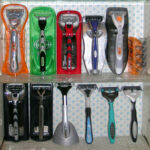Somewhere around the age of ten I expressed an interest to my dad about shaving. I’d often sneak a watch while he shaved a day’s growth of whiskers. I figured it was time for me to pick up this manly habit. Dad obliged by filling my hand with shaving cream which I eagerly smeared all over my face–head, ears and hair. He handed a one-piece double-edge safety razor to me and motioned toward the mirror. He never cracked a smile so I didn’t think he was making fun of the gob of shaving cream sitting on my skinny shoulders covering my head. This was serious business–a rite of manhood! I can tell you now that I got the job done. The shave went without a hitch. My face was smooth as a ten year old’s cheek could be . Of course there was no blade in the razor, but that was a minor hitch and didn’t affect the outcome at all. I had no whiskers. From this humble beginning and after more than 50 years of shaving I figure I’m an expert in razors and shaving. With this kind of background there’s nobody better suited to give a little personal history on safety razors and answer one of the burning questions of modern times: Do we need all those blades?
Invention of the modern razor.
There’s a reason why the old western gunfighter held a gun on the barber as he shaved the exposed and outstretched neck. Straight razors are dangerous! It takes skill and practice to use a straight razor. In 1762 Jean Jacques Perret invented a wooden guard for the conventional straight razor. There were other guards along the way but it wasn’t until 1847 that William S. Henson of England patented a guarded razor generally in the shape of modern razors. The patent described the razor as “…a cutting blade at right angles to the handle, and resembles somewhat the shape of a common garden hoe.” The guard was a metal toothed comb that extended below the edge of the blade.
What is a safety razor.
My grandfather used a straight razor. My Dad said that’s something I didn’t want to mess with. I took his word for it. I started shaving with a razor that opened on top with a twist of the handle. A double edge blade was placed in the opening and tightened down with another twist of the handle. The Merriam-Webster Dictionary definition of a safety razor is: a razor provided with a guard for the blade to prevent deep cuts in the skin. Notice the words “deep cuts.” You can still cut yourself, but at least you won’t slice off your ear or cut your throat.
How do safety razors work?
I’m being detail oriented here because we’re working up to the answer of the burning question. At 18 I shaved once a week or so. Probably could have gone longer and used a dull pocket knife because all I had was a little peach fuzz. Shortly the whiskers toughened and the razor blades dragged. After awhile it seemed the blades pulled each whisker out by the roots. I guess I’m just a sensitive old wimp, but it hurt. Shaving cream helped, hot water helped even more. I figured out why the old barber soaked whiskers under a hot wet towel. The best blades available dulled very quickly. What other choice did we have?
The stainless steel revolution.
The Gillette business model was to almost give away a handle and sell good enough blades at high profit. Everybody shaved and there was little competition in the 1960s. But, along came the stainless steel Wilkinson Sword blade–expensive, sharp and long lasting. Well worth the money. This forced Gillette to sit up and pay attention.
The multi-blade fandango.
I use the word fandango because it is a lively dance and/or tomfoolery. In more than 50 years I’ve tried every type and rendition of razor. The original plastic disposable razors were cheap but adequate. Quality and utility improved over the years. Extra blades and lubricating strips were added. Heads pivot. Three and four blade cartridges hit the shelves. Now you can get five blade cartridges–six if you count the trimming edge. I suspect there are retired NASA scientists sitting in little rooms figuring out how to add more blades.
The five blade razor feels and looks like a miniature lawnmower on my face, I can’t see where I’m shaving and certainly can’t accurately trim sideburns or under my nose. The pivoting head leaves no control. I’m glad my wife got this thing free with coupons.
Do we need all those blades?
Not unless you plan to shave the hair off a cow.
The razor I want.
A long, good quality handle with a little heft to it and a single blade cartridge with lubricating strip. I’ll take two blades if I have to. Razor companies need to start a new business model consisting of quality, utility and common sense. Free advice, take it or not.


